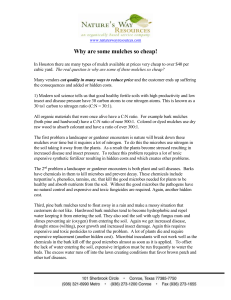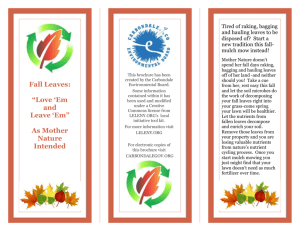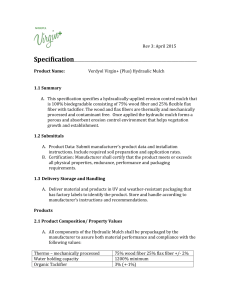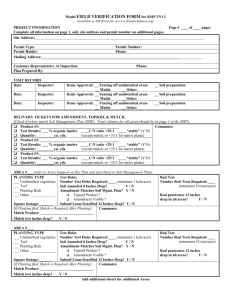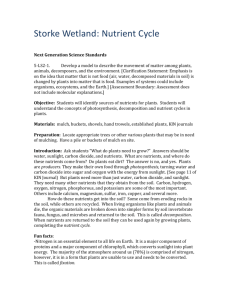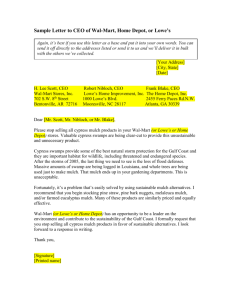The Effects of Colored Mulch on Cucumber Transplants Hort 433 4
advertisement
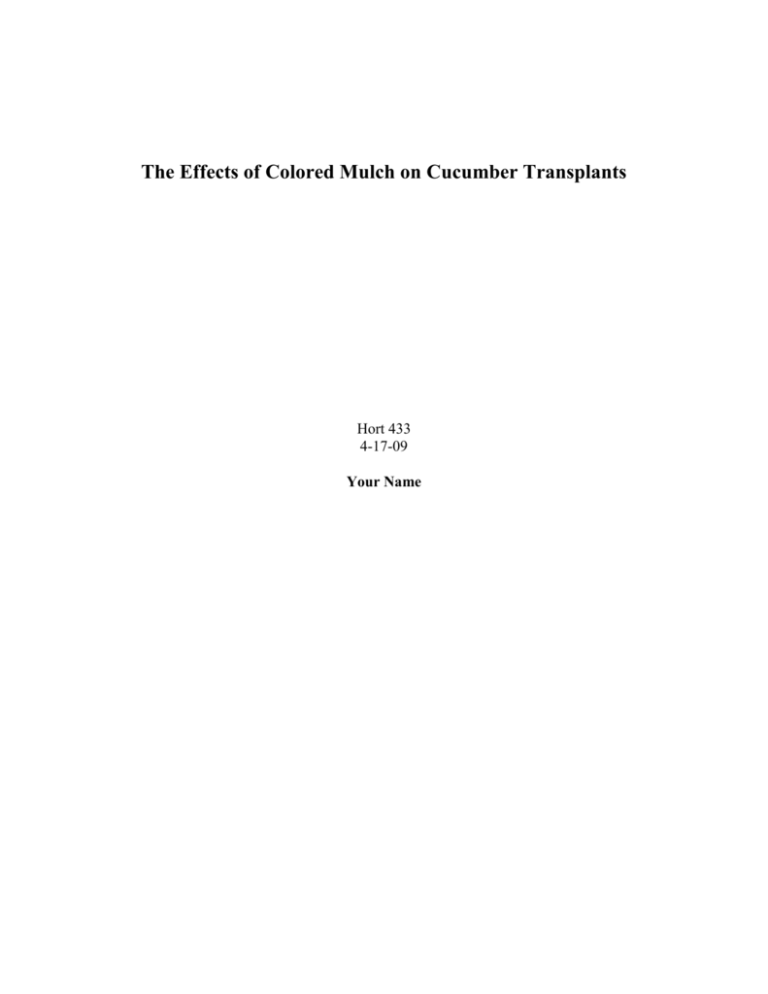
The Effects of Colored Mulch on Cucumber Transplants Hort 433 4-17-09 Your Name Introduction: Plasticulture is a common method used to grow vegetable crops. The term plasticulture is used to describe the use of plastic mulches in agricultural production. Plastic is generally laid on the ground or a raised bed along with a drip irrigation system to supply water to the crops. Plastic mulches have many advantages and these advantages are why the practice of plasticulture is becoming more and more popular. The first advantage of using plastic mulch is the regulation of soil temperature. When soil temperature is increased this allows crops to be transplanted or seeded sooner, thus allows the producer to get a jump start on the market. Some crops tend to produce better under conditions when the soil temperature is increased. Other advantages of a plasticulture system include, reduced soil compaction, reduced evaporation, a cleaner product, and reduced weed problems (Sanders). Disadvantages of using a plasticulture system include a high cost for removal, greater initial cost, increased management, increased soil erosion, and increased crop/weed competition. Even though there are disadvantages associated with the use of plastic mulches, many growers have found that the advantages outweigh the disadvantages, and plasticulture is becoming more popular (Sanders). Plastic mulches have been used by gardeners, both home and commercial, in the belief that they will raise soil temperatures. Plastic mulches can do this, but application is crucial. The underside of the mulch must be in direct, firm contact with the soil underneath it. Black-plastic mulch has been the top choice for mulching and still predominates in cool climates. In hot areas, white plastic is actually used to reduce excessive soil temperatures. An alternative is clear plastic. It provides substantially greater soil heating than black plastic. Clear plastic is much more expensive than black plastic and also has rampant weed growth under it (Growing Taste). Today there are more options available than just black, white, and clear mulch. Mulches are available in red, green, blue, grey, and many other colors. The physics behind colored mulch is this. When black plastic mulch is struck by sunlight, it absorbs most of the energy in that light at all the wavelengths of significance, including ultra violet, visible, and infrared. The black plastic them re-emits the energy as a long wavelength also known as thermal radiation. Clear plastic on the other hand, obviously absorbs little solar energy, but rather passes the majority of the energy to the soil underneath of it. However, white mulch doesn’t absorb much heat, but does not allow much radiation of heat to pass through it either. Therefore, clear mulch will produce the warmest temperatures, followed by black mulch, and lastly white mulch will usually actually reduce soil temperatures (Growing Taste). However, the answer to mulching is not simply black and white. In recent years, it has been shown that selecting a plastic mulch of the “right” color can improve both growth and yields of the crops. Choosing the right color is twofold; first it depends on the crop being grown, and second it depends on the climate that the crops are being produced in. The purpose of this experiment is to determine the effects that different colored mulches will have on the growth of cucumber transplants. Our hypothesis for this experiment is that the darker plastic mulches will create a better environment for cucumber growth than the lighter mulches and the control with no plastic mulch. Materials and Methods: For this experiment three colored mulches were used and a control group with bare soil. The colors used were blue, red, and grey. Two cucumbers were planted in potting media in each large tray. The large trays were covered with the plastic mulch and tied with string. A drip irrigation system was set up to provide the cucumber transplants with adequate water. There were a total of eight cucumber transplants used in this experiment. Two transplants were used for each color of mulch and also two cucumbers for the control group. Data was collected regularly. Data collected included height of plant, number of male and female flowers, and soil temperature. The transplants were grown in the greenhouses. After a few weeks of growth the cucumber transplants began to vine out and grow tendrils. The cucumber plants were then trellised. Results: The data produced from this experiment did not give staggering results. All eight cucumber plants from their respective mulch color or control tray had similar vegetative and reproductive growth. In the early vegetative stages each plant was measured on February 17th and then again on February 27th. This was day zero of the experiment and day ten. Figure 1: Figure 1 shows the plant height that was recorded at the beginning of the experiment. At the start of the experiment, the control plants were taller. Figure 2: Figure 2 represents the plant height after 10 days of the experiment. All the plants were about equal in height, except for a plant in the grey mulch and a plant in the blue mulch had grown taller than the rest. Figure 3: Figure 3 represents the average plant growth after 10 days of the experiment. The transplants grown with the grey mulch seemed to have the most growth. However, the rest of the plants were not far behind. Figure 4: Figure 4 represents the soil temperature, under each mulching condition. The soil temperature was highest for the blue mulch and the control with no mulch. Figure 5: Figure 5 shows the number of female flowers that each cucumber plant had. Discussion: Our original hypothesis was that the darker mulches would result in more plant growth, because they would create a warmer soil temperature. The blue mulch, one of the darker mulches used, did indeed create higher soil temperatures than the red and grey mulch. However, the control plot also had a high soil temperature, which doesn’t make too much sense. This is probably due to sources of error. In order for the mulch to function correctly, the mulch needs to be directly touching the soil surface. It was difficult to fill the trays to the top, so that the mulch was directly touching. Therefore the mulch may have actually been a cooling factor rather than a heating factor, because of the air space that was between the mulch and the soil. In this experiment the plants with grey mulch actually grew more in the vegetative stage than all the others. Grey was one of the coolest soil temperatures. The optimum soil temperature for cucumbers is about 70 degrees Fahrenheit, so therefore this actually makes sense. The soil conditions and temperatures under the other two types of mulch and control group may have actually been to warm for optimal growth. Error could have occurred with the temperatures too, because the soil temperature was only measured once. After the plants really took off it was hard to distinguish which plants were doing the best because they all were growing vigorously and vining everywhere. The majority of the flowers on all the plants were males, so we took data to see which plants had the most female flowers. The control plot had 8, blue had 5, red had 6, and silver had 8. It should be noted that the best fruit came from the silver tray; these plants produced some nice large cucumbers. Our hypothesis that darker colored mulches would produce better growth than light colored mulches can be rejected using our results, but as mentioned earlier our results do not show statistical significance. It was hard to evaluate the effects of colored mulch on the growth of cucumber transplants, because our data did not show statistical significance. The main reason for this is because once the plants started to mature they became impossible to measure. Noticeable differences weren’t observed but this doesn’t mean that mulches (and different colors of mulches) have little impact on the production of crops. There are many advantages that have been proven such as increased soil temperatures (especially in early spring), less weed problems, moisture conservation, reduction of certain insect pests, higher crop yields and more efficient use of soil nutrients (Orzolek). I think the main reason that significant differences weren’t observed is because the plants were growing in a perfect environment in the greenhouse. The plants didn’t experience the cool spring temperatures like they would have if they were growing outside. If they were outside, the plants grown with the mulch would have definitely had a much faster start than the control plot due to warmer soil temperatures. The different mulch colors help plant growth under different conditions of stress; in the greenhouse plants don’t have to deal with much stress so that’s probably why we didn’t get the best data. For future experiments, it would be interesting to perform this same experiment in outside field conditions. If this experiment is to be performed in the greenhouse, it would be wise to grow crops that do not vine, so therefore they could be measured throughout the experiment, unlike the cucumber plants. This is an interesting experiment and should continue to be researched. If producers can harness the use of colored mulches specific to their crops, yields can be greatly increased. With the growing population and the decrease of farmland, yields are of utmost importance in the agricultural industry. References: Sanders, Douglas C. “Using plastic mulches and drip irrigation for vegetable production” North Carolina State University. Orzolek, J. Murphy, and J. Ciardi. "The Effect of Colored Polyethylene Mulch on the Yield of Squash, Tomato and Cauliflower." 2003 Web.16 Apr 2009. <http://plasticulture.cas.psu.edu/CMulch-93.htm>. Growing Taste: A Home Food-Gardening Resource’ “Colored Plastic Mulches for Vegetable Gardening” http://growingtaste.com

